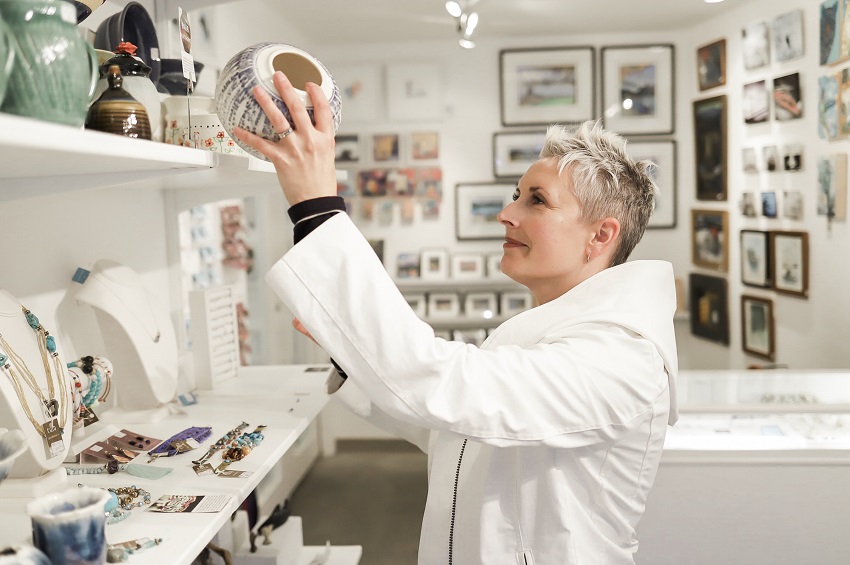
Artwork is one of the most effective ways to introduce colour, drama, and personality into a space. Art evokes emotion and creates conversations, bringing spaces to life.
That is why we love introducing clients to some of our favourite artists and their work. We always strive to incorporate original art into our clients’ homes.
You don’t have to be an art historian or art expert in order to start an art collection.
Today I’m sharing 5 simple tips to help you get started…

1. Determine Your Art Collection Budget
A common misconception is that art has to be expensive to be good. I bought my first original photograph at an art show for $125 while I was attending university. You can still start collecting art that you love even if you are on a tight budget.
Visit local art fairs and look for works by up-and-coming artists, or consider starting with a few smaller pieces. Limited edition prints are also a great alternative to original works. There are lots of options out there and they don’t have to be expensive.
When budgeting for design projects, we always include a line item for artwork. If you are interested in building an art collection, we suggest putting money aside monthly or yearly to help you budget for larger pieces over time.
Art can be a great gift if the buyer has proper direction (so drop some hints come your birthday or Christmas). After last year’s East Van Culture Crawl I told my husband about an artist I had met and left her card on the kitchen counter. Come Christmas morning one of the paintings that I had coveted was wrapped up under the tree!

2. Seek Art that Speaks to You
When selecting artwork, I encourage you to listen to your gut because ideally you want your artwork to evoke emotion. There are dozens of reasons that a piece may speak to you. It could be a specific place, subject, or aesthetic.
If you are lucky enough to meet the creator, it might be that you relate to the artist as a person or that the story behind the piece resonates with you. Don’t be influenced by the cost or what others think. You should focus on choosing something that will bring you joy every time you see it.
There are many places to find art and we encourage you to start with local art shows and galleries. Supporting local artists ensures a vibrant art scene in your own community. You may also look to purchase art when you are on vacation because it reminds you of a special location or experience.
While it is possible to research art and artists online, we encourage you to see works in person where possible since you cannot always be sure that the colour, texture, and scale are accurately represented in a photo.

3. Mix and Match Your Art Mediums
When most people think about art, they tend to think paintings on canvas, but don’t forget about all of the other types of art: photography, drawings, collage, textiles, 3D art installations, and sculpture. Not to mention a variety of mediums from works on canvas and paper to ceramics, glass, metal, and wood. Get creative and consider a mix of mediums.
With so many diverse and exciting mediums available, there is no need to limit your collection to just a few. Choosing a variety of mediums will make for a more interesting, curated collection that, in turn, adds intrigue to your surroundings.

4. Incorporate Art into Every Room of Your Home
So you have collected some great pieces of art…now what? Keep in mind that art plays an important role in setting the tone for a room and can be an effective jumping off point for a design scheme.
You can approach incorporating art into your space in one of two ways:
- First, if the artwork is bold and colourful, you can display it against a neutral backdrop where it can be the star of the show. In this case we may pull a few colour references from the work into the decor scheme, but for the most part the space is neutral so the artwork stands out.
- A second approach is to go with the exuberance and surround the art with colour, magnifying the energy of the work in the space.
Your approach will depend on the mood that you are trying to create.

In this formal living room that our clients use as a retreat from the hustle and bustle of their busy family room, we recommended the work of Lisa Ochowycz and surrounded it with neutral tones to create a relaxing environment. You will notice subtle references to the colours found in the artwork on the toss cushions, but they do not overpower the art which remains the focal point in the room.

5. Place Your Art in Unexpected Locations
When it comes to displaying art, there are all of the conventional places – on the fireplace mantle, behind the sofa or over the bed – but don’t limit yourself to these obvious locations.
We love placing art in unexpected ways: in bookshelves, on desk surfaces, or even in the kitchen and bathroom.
Be conscious that the medium suits the location. For instance, you wouldn’t want to place a delicate work on paper in a high moisture area like a bathroom or a piece prone to fading in a sunny window.

A final note about building your art collection…don’t be too concerned about how the pieces work together. Yes, you can consider an overall colour scheme or theme, especially if you are displaying your artwork in close proximity or as part of a gallery wall. However, in most homes you have the space to diversify, creating different moods in different rooms.
And remember, if you are unsure about how to get started, we are here to help!
Until next time,
Lori











